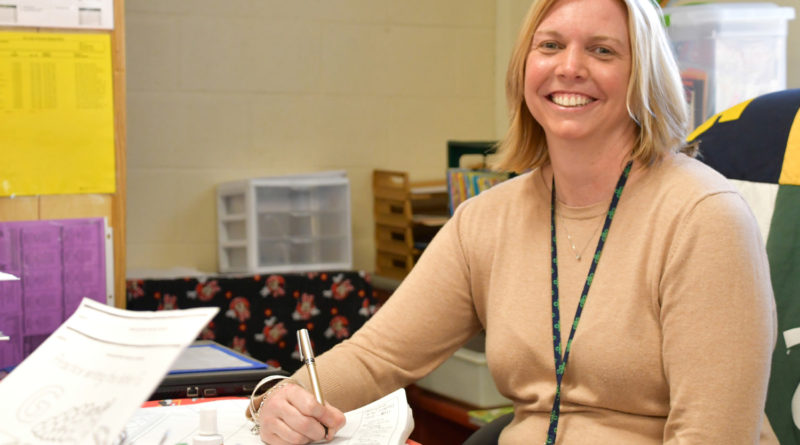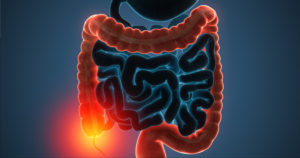Woman’s story underscores trend of younger cases of colon cancer
Life changed rapidly for Rhonda Eckman, of Coal Township, in 2016.
Abdominal pain that started more as a nuisance elevated to extreme, sharp-shooting pain that doubled her over, making it hard to operate her growing daycare center.
“It started developing in my right side of my lower abdomen. It came and went, but nothing too severe. I thought maybe it was just a pulled muscle,” said Eckman. “But the pain got a lot worse. It would double me over. I went in for some bloodwork and the doctor called me back to tell me my numbers were off the chart — something was going on here.”
The discovery led to a lengthy hospital stay and a dire diagnosis — Stage 4 colon cancer.
“It just all happened so quickly,” she said. “I went to an appointment, was admitted to the hospital for 10 days and then four days after that, I was starting chemo.”
Concerning trend
Eckman’s situation highlights a growing trend in the world of colon and rectal-related cancers — the condition is cropping up more regularly in younger patients.
Eckman was 45 at the time of diagnosis. Most insurance companies don’t cover potential life-saving colonoscopy screenings in regular patients until age 50.
“For the average-risk patient with no significant family history of colon cancer, the American Cancer Society, up until recently, recommended starting colonoscopy screenings at age 50,” said Dr. Julie Woods, of Geisinger, who treated Eckman throughout her ordeal. “With such a trend in colon cancers toward younger ages, that recommendation just last year was changed to age 45. For those who are at higher risk, it can be much sooner.”
Dr. Joseph Gallagher, of Evangelical Community Hospital, agreed that he’s seen an increase in younger patients with colon cancer.
“Overall, people have a 1-in-18 to a 1-in-20 chance of getting a version of colon cancer,” he said. “About 90 percent of those cases are in patients over the age of 40, but we are definitely seeing a trend toward younger patients.”
The reason for that trend is still uncertain, but Woods and Gallagher both have theories.
“Diet and lifestyle play a big role,” said Woods. “As more and more people lead a more sedentary lifestyle and make poor food choices, it can create a ripple effect that effects numerous parts of the body.”
Gallagher agreed.
“The increase in obesity may play a big role in the increase in younger cases of colon cancer,” he said. “It underscores what we recommend to all people wanting to proactively try to avoid cancer — eating a diet rich with fruits and vegetables can decrease the rate of cancer, as can a diet low in animal fat. Alcohol and tobacco use are also independent risk factors that can lead to colon cancer.”
Life-saving support
Eckman’s cancer was initially diagnosed as ovarian, but the cancer found in her ovaries started originally in her colon.
“It had spread to my ovaries, and there was even a spot on my liver. It was determined that the cancer was too large for an operation, so I started a six-month regiment of chemo,” she said. “Thankfully, the treatment worked — the cancer shrank. In December of 2016, they were able to do the surgery and I have been cancer-free ever since. I did go through six more months of maintenance chemo to help keep the cancer from returning.”
The entire process was a challenge, but Eckman said she tackled it with a positive attitude.
“I decided from Day 1 that I was going to beat this, and as bad as it seemed at times, it was important to stay positive and not feel sorry for myself,” she said. “The worst part of it all was that I had to close my licensed day care and preschool program. I worked there basically by myself and had to let that go. I so badly missed the kids.”
Family and community support helped Eckman through the grueling process.
“Fundraisers and T-shirts and bracelets and 5K walks/runs, everyone came together and I received the best support ever. I could never repay what the people around me did for me through it all,” she said. “I even received a call from Our Lady of Lourdes, where I went to high school. Both of their preschool teachers were retiring at the same time, and I was asked to join their staff.”
Eckman is giving back the only way she knows how — by helping others via volunteering with Camp Dost, a camp for children with cancer. She is also an advocate for colon screening.
“I encourage everyone I can to get screened,” she said. “I am 48 now and a lot of my friends are reaching 50. Make sure you get a colonoscopy as soon as you can. You never know what may happen.”
What to expect at a colonoscopy
There are numerous ways to screen the colon for possible cancer. Unfortunately, the most reliable is also the most notorious.
The colonoscopy.
However, the procedure can be a life-saving experience.
“Colon cancer screening is increasingly important. When a colon cancer is detected, there is upwards of a 90 percent chance for survival in Stage 1 cases,” said Dr. Julie Woods, of Geisinger. “If we can find polyps that may be concerning and remove them, it greatly improves the odds.”
If screenings are skipped, survival rate over a five year period after diagnosis drops significantly.
“By the time you get to Stage 3, which is where the cancer has spread to nearby lymph nodes, the five-year survival rate drops to 40 percent,” Woods said. “In Stage 4 cancer, where the cancer spreads beyond the colon and rectum area and to distant parts of the body, the five-year survival is around 15-17 percent.”
Dr. Joseph Gallagher, of Evangelical Community Hospital, agreed.
“One of the biggest fears of getting a colonoscopy is that something may be found,” he said. “But if you have polyps, you want them found. The sooner you do, the better the chance they won’t become something serious.”
The procedure
“People definitely have a lot of anxiety about getting a colonoscopy, although the hardest part is usually the prep beforehand,” said Gallagher. “It is also one of the most important parts because we need to clean everything out to get a good idea of what is going on in the colon.”
However, even the prep part has gotten better over time, added Woods.
“It is a lot more tolerable. In many cases, Gatorade can be used instead of the chalky laxative we used in the past,” she said. “The key is to stay near a bathroom and to stay hydrated.”
The next step is to receive the colonoscopy itself — a same-day procedure, according to Woods, that usually only takes 20-30 minutes if there are no abnormalities.
“We bring you into the center, put an IV in and hook up a monitor. An anesthetist then sedates you, and most people barely remember the procedure,” Gallagher said. “Once sedated, we do a rectal examination, scanning with a scope around the entire colon. If we find any polyps, we take them out.”
Colonoscopies are not painful in most cases.
“For us, 99.9 percent of people say they went to sleep, woke up and don’t remember anything. For some, they say it is the best nap they’ve ever taken,” Gallagher said. “In fact, I had one guy upset recently because he was about to land a 24-inch brown trout when we woke him up at the end of the procedure.”
For most people — those without an inherit risk of colon cancer, such as a family history — colonoscopies are recommended by the American Cancer Society starting at age 45. That age has dropped from the previous recommendation of starting them at age 50. However, many insurance companies won’t pay for procedures before 50.
Once started, it is recommended, for those with low risk, for return colonoscopies every 10 years moving forward.
“It usually takes 7-10 years typically for a polyp to develop into cancer,” Gallagher said. “We like to do whatever we can to prevent the disease.”
According to Woods, there are things people can tweak in order to help be proactive.
“There are risks that can be changed, and those that can’t,” she said. “People can’t change their genetics and family history, but they can change diet, exercise and overall lifestyle. We recommend limiting high fat red meat and avoiding smoking, which can cause multiple types of cancer, not just colorectal.”


